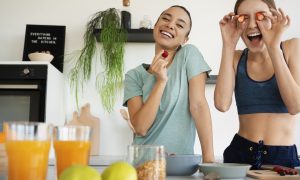Your best performance starts in the days leading up to show time. You can make this year your best spring performance ever with these key nutrition tips.
Don’t wait until show day to eat right.
2 days before:
Make sure your post-exercise meals have complex carbs and protein and are eaten within 30 minutes after class or rehearsals. This ensures your storage tanks of energy, called glycogen, get refilled and muscles get the building blocks they need to repair. Example meal: minestrone soup with vegetables (which decrease inflammation and provide vitamins), beans (full of protein, iron and zinc) and whole grain or quinoa pasta (to refuel glycogen stores). Serve with a side salad with nuts, seeds or the new Beyond Meat brand “chicken” strips that are made with pea protein, which is easily digestible and is less inflammatory than protein from red meat1. Decrease inflammation and sore muscles by eating lots of vegetables, moderate fruit intake and making sure you are getting adequate Vitamin D. Consult with a dietitian to check if there are other vitamins and minerals you may need to supplement.
1 day before:
Do not crash diet this day in particular. This is the day to make sure you eat and drink regularly throughout the day so you do not deplete glycogen stores. If you rehearse or take class, make sure you eat a meal with carbohydrates such as sweet potato and black bean tacos within 30 minutes post-exercise to maximize stored energy that can be used on show day.
Show time: What to eat for fuel when you’re nervous.
2-3 hours pre-show:
Eat a substantial meal with a mix of complex carbohydrates, moderate protein and moderate fats. For example: quinoa pasta with a light marinara sauce topped with peas (or other starchy vegetable) and a side of whole grain toast with a drizzle of olive oil or coconut oil.
30 minutes to 1 hour pre-show:
Have something light and easy to digest that is mostly carbohydrates, like a banana, crackers or rolled oats and almond milk. This is not the time to grab a burger and fries or cookies. Real athletes know that smart carbs are the stars of performance nutrition.
During show:
Sip on a store-bought hydration beverage, or make your own if the food dyes in them affect your concentration. Mix 4 cups water with 3-4 tablespoons organic sugar or honey, ¼ teaspoon salt and your favorite flavoring like lemon-lime juice or herbal tea. Another idea is to keep salty crackers, dried fruit and water on your dressing table to grab mini-bites during intermission. Avoid excess caffeine. While small amounts of caffeine might boost performance for those already accustomed to its effects, excess will make you jittery and more prone to injury. Caffeine can never replace the energy you get from real food.
Hydrate before, during and after.
The first two signs of dehydration are fatigue and poor balance. The brain doesn’t even register thirst until the body has already lost 2-3 liters of fluid. If you’re thirsty, your performance is decreased by at least 20 percent. Soda with high fructose corn syrup is not your friend; stick with water.
1 day pre-show:
Drink regularly throughout the day with a total of at least 80 ounces (2400 ml). Avoid dehydrating substances such as alcohol and excess coffee.
2-3 hours pre-show:
Drink at least 17 ounces or more (500 ml).
During show:
Sip on water or a rehydration beverage with electrolytes as needed to avoid thirst and reduce muscle cramping. Try a small serving (4 ounces) of performance-boosting beverage with a mix of fresh squeezed orange juice (contains potassium), beet root juice (contains the good kind of nitrates), and juice or tea for flavor. If too much fructose from fruit juice bothers your stomach, reduce the portion size or stick to water.
This is not the time to crash diet.
Everyone wants to look their best for their end-of-the-season shows, but going on a crash diet leading up to the show will undoubtedly lead to muscle loss and increases risk for injury. When you restrict food (i.e. energy) intake, your body responds by having to find fuel from somewhere else. Some of your own hard-earned muscle tissue actually gets broken down and used as fuel. It’s similar to the idea of burning your furniture to heat your house. In addition, the body decreases your resting metabolic rate, which overtime ends up backfiring by leading to weight gain in the long run when you go back to eating normally.
Eat well, hydrate well, and you will dance well.
 By Emily C. Harrison MS, RD, LD of Dancer Nutrition.
By Emily C. Harrison MS, RD, LD of Dancer Nutrition.
Emily Cook Harrison MS, RD, LD
Emily is a registered dietitian and holds both a bachelor’s and master’s degree in nutrition from Georgia State University. Her master’s thesis research was on elite level ballet dancers and nutrition and she has experience providing nutrition services for weight management, sports nutrition, disordered eating, disease prevention, and food allergies. Emily was a professional dancer for eleven years with the Atlanta Ballet and several other companies. She is a dance educator and the mother of two young children. She now runs the Centre for Dance Nutrition and Healthy Lifestyles. She can be reached at emily@dancernutrition.com
www.dancernutrition.com
Sources:
- Ndiaye F, Vuong T, Duarte J, Aluko RE, Matar C. Anti-oxidant, anti-inflammatory and immunomodulating properties of an enzymatic protein hydrolysate from yellow field pea seeds. Eur J Nutr. 2012 Feb;51(1):29-37. doi: 10.1007/s00394-011-0186-3. Epub 2011 Mar 27.















